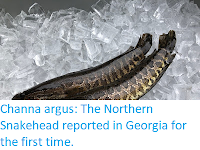Sillagos, Sillago spp., are inshore Perciform Fish widespread in the IndoPacific region. They form an important part of many food webs, feeding on Crustaceans and Molluscs in coastal waters or estuarine areas of rivers with open sandflats and muddy substrates, and in turn being fed upon by larger Fish, Marine Mammals, and Seabirds. Understanding the population structure of these Fish has proven difficult, as the genus contains a large number of very similar-appearing species, often identifiable only by the structure of their swim bladders, with the recent application of genetic profiling to the group suggesting that even this is not reliable, and that the group may contain more cryptic species (species which cannot easily be told apart by physical examination) than previously realised.
In a paper published in the journal Fishes on 18 April 2022, Shilpi Saha of the Fisheries College at the Ocean University of China, and the Department of Zoology at Jagannath University, Na Song and Zhengsen Yu, also of the Fisheries College at the Ocean University of China, Mohammad Abdul Baki, also of the Department of Zoology at Jagannath University, Roland McKay of the Chillagoe Museum, Jianguang Qin of the School of Biological Sciences at Flinders University, and Tianxiang Gao of the Fishery College at the Zhejiang Ocean University, describe two new species of Sillago from Bangladesh.
The new species are described from specimens obtained from fishermen at locations in Cox’s Bazar, Sundarbans, Patharghata, Maheshkhali and Saint Martin’s Island. These Fish are typically caught using beach seine nets in this area.
The first new species described is named Sillago muktijoddhai, were 'muktijoddhai' refers to the muktijoddha freedom fighters who fought for Bangladesh's independence from Pakistan from 1971 to 1979.
Sillago muktijoddhai is elongated in shape, slightly steep anteriorly, and tubular posteriorly. The upper jaw is slightly protracted and crescentic, with minute villiform teeth on both jaws in one row. The back edge of the preopercle is slightly denticulated, and the opercle has one fragile spine posterodorsally. Gill rakers on the first arch are pointed and gradually become short towards the end. The body is covered with moderate-sized, overlapping ctenoid scales. The cheek scales cycloid, arranged in two rows.
There are two distinctly separate dorsal fins. The first dorsal fin is higher than the second, originating above the pectoral-fin base; its second spine is the longest, and the length of the succeeding spines decrease gradually. The base of the second dorsal fin is long, beginning at the midbody and not reaching the caudal-fin base when depressed. The anal fin originates slightly posterior to the anus, not reaching the caudal-fin base when depressed. The two disconnected pelvic fins are wide, roughly three-cornered, and shorter than the pectoral fin.
The body of Sillago muktijoddhai is greenish dorsally and light yellowish ventrally with black dots on the side below the lateral line. The cheek has black dots gathered on the anteroventral part of the eyes. The dorsal fins are hyaline, and small dark spots exist on the fin membrane, but those on the second dorsal fin form two or three distinct rows. The pectoral and pelvic fins are light yellowish. The anal fin is light yellowish with black spots. The caudal fin is light yellowish, dusky, and with a white edge; the lobes are truncated or emarginated.
The second new species is named Sillago mengjialensis, where 'mengjialensis' means 'from Mèngjiālā', where Mèngjiālā is the Chinese name for Bengal, in reference to the fact that the species was discovered as part of a collaborative project between scientists from China and Bangladesh.
The body of Sillago mengjialensis is elongated, somewhat conical anteriorly, and cylindric posteriorly. The back edge of the preopercle is slightly toothed. The opercle only has one weak spine posterodorsally. The gill rakers on the first arch are pointed and gradually become small towards the end. The body is covered with moderate-sized, overlapping ctenoid scales. The cheek scales are cycloid, arranged in two rows.
There are two disconnected dorsal fins. The first dorsal fin is higher than the second, originating above the pectoral fin base; its second spine is the longest, and the length of the succeeding spines decreases gradually. The base of the second dorsal fin is long, beginning at the midbody, and not reaching the caudal-fin base when depressed. The anal fin originates slightly posterior to the anus, not reaching the caudal-fin base when depressed. Two disconnected pelvic fins are large, roughly trigonal in shape, and smaller than the pectoral fin.
The body of Sillago mengjialensis is light olive greenish dorsally and silver ventrally with black spots on the sides below the lateral line. The cheek has black spots gathered on the anteroventral part of the eyes. The dorsal fins are hyaline with small dark spots on the fin membrane adjacent to the ray. The pectoral and pelvic fins are light yellowish. The anal fin is light yellowish to whitish with black dots. The caudal fin light yellowish, dusky, and has a white margin; the lobes are truncated or emarginated.
See also...



Follow Sciency Thoughts on Facebook.
Follow Sciency Thoughts on Twitter.





